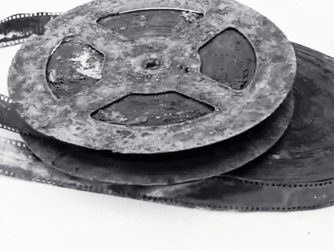
Each month, the Indie Prof reviews a current film in the theater and second film or series available on DVD or instant-streaming service.
Follow “Indie Prof” on Facebook for updates about film events and more reviews.
Dawson City: Frozen Time (2016)

Dawson City
Silent film was all film. In other words, every silent film was shot on 35mm film stock and most of it was highly flammable. Stories of early film screenings ending up in flames are legion, and film vaults were notoriously dangerous crucibles. For this reason, as well as the sheer volume of movies that were shot in the silent era, many silent films were destroyed; in fact, over 70 percent of all silent films have been either lost, burned, or destroyed. So much of film history is just gone.
That is what makes the story of Dawson Creek, a Yukon town in northwestern Canada, so fascinating and remarkable. One day in 1978, a man was clearing land with a backhoe, breaking ground for a new building in the town. When he unearthed something peculiar, he stopped to look. It was film: hundreds of reels of film stock that had been buried in the permafrost for decades. The new documentary Dawson City: Frozen Time chronicles how the film was found, how it got there, what is on the film, and the stories of the town, the people, and the times. It is a remarkable story and just as equally remarkable a film that puts it all together.
Dawson Creek was an 1800s trapping and hunting town that became overrun in 1896 when gold was discovered. The town saw a boom and then the inevitable bust, but it normalized and eventually became a corporate mining town. Since Dawson Creek was the end of the line for film distribution, movies that landed there stayed there. The studios did not want to pay for their return, so the films were burned or dumped in the river, like so much garbage from the town. But a curious architectural hiccup in one of the town’s buildings would become the final resting place of many of the films. These are the films that were found in the late ’70s.
The film itself is remarkable, tracing the town’s history and the stories therein. Then it uses the found footage to help tell the stories, as if the silent films were acting out the will of the filmmaker. If you enjoy editing, if you enjoy history, if you enjoy movies, then this film is a must-see. It is lightning in a bottle, or more accurately, lightning in a film reel. The people are brought back to life, the stories are brought back to life, and life is brought back to life. It is all truly film magic.
You will like this film if you enjoyed Hearts of Darkness, Chaplin, or any silent film ever made! Opens at the Sie Film Center on 8/25.
American Gods (Starz)

American Gods
You know that feeling after you’ve seen the movie version of one of your favorite books? Terrible. The movie was not the movie you had running in your head as you read the novel, right? To be fair, they are two completely different mediums. And oh yeah, you did not direct the film. But enter Series TV, where the adaptation business is strong and continuing to grow. My review of The Handmaid’s Tale last month highlighted one of those great adaptations, and this month’s show is along those lines. The new Starz series American Gods, based on the wildly popular and wonderfully bizarre Neil Gaiman novel, is a winner. Series TV continues to improve, and the adaptation is a growing star.
Season one of this adventurous and trippy series is now available on Starz. For those familiar with the book, it covers essentially the same ground with changes to several aspects. But that should be expected. What wasn’t so expected was the outrageousness of the cinematography and the ability of the show to highlight the visuals of a written story. It is mind-bending, fantastic, iridescent, and sometimes straight-up-whacked-out over-the-top. The cinematography and editing are particularly striking, breathing fiery life into Gaiman’s dense verbiage in ways that surprise and delight. Every episode has its own feel while the show manages to retain a holistic vision. It’s quite mind-blowing.
The story is too complex to describe, but suffice to say it depicts a contemporary war between the old gods and the new gods. Reading the book is not a prerequisite, but it certainly helps. Still, the visual incarnation has its own life and well, what a life that is. Ricky Whittle is very good as Shadow, Ian McShane is fantastic as Mr. Wednesday, and Emily Browning is magnetic as Laura, stealing every scene she is in. The secondary parts are all well-drawn and well-acted, including stints by Peter Stormare, Crispin Glover, and Gillian Anderson. The writing is crisp, snappy, and full of life. Even when the character is dead.
Season one is available on Starz. You will like this series if you enjoyed Game of Thrones, The Handmaid’s Tale, and/or Better Call Saul.
Vincent Piturro, Ph.D., is an associate professor of Cinema Studies at Metropolitan State University of Denver. He can be reached at vpiturro@msudenver.com.



0 Comments